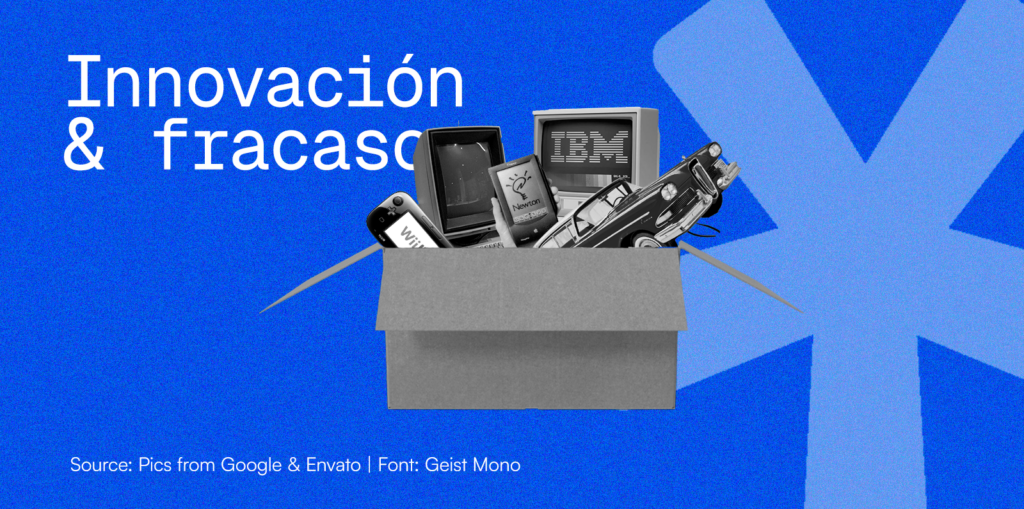We are used to hearing success stories about great entrepreneurs and how they reach the top. But why don’t we talk about failures? Are failures perhaps understood as an end?
Undoubtedly, in the field of development and innovation, failure is commonplace. Projects that stay in the background may, years later, resurface in another form. In the world of innovation, the word “success” does not emerge on the first attempt. Just ask many iconic companies that faced failed projects before reaching the summit.
Today, we bring you some inspiring cases where failure wasn’t the end but the beginning of something even greater!
In 1993, Apple launched the Newton, one of the first personal digital assistants (PDA), which turned out to be a complete failure. Although ahead of its time, such devices didn’t exist in the market, and the Newton ended up being a total fiasco. There wasn’t a single unequivocal reason why it didn’t work, but rather a combination of variables, missteps, and delays that resulted in a gadget with numerous problems and too many promises, coupled with its high price.
Apple continued to work on developing devices of this type until, in 2007, it launched the iPhone, a device that changed the paradigm of mobile phones. Can we say that the Newton was the conceptual precursor to the iPhone? One thing is clear: the initial failure was key to creating one of the most successful devices in history.
Nintendo, the great Japanese entertainment company, launched the Wii U in 2012, hoping to replicate the success of its predecessor, the Wii. However, its reception was different; marketing issues and a lack of clarity in conveying the advantages of its new dual-screen concept resulted in very low sales and a threat to its dominance in the video game market.
They went from selling 100.8 million units with the Wii to just 5.3 million with the Wii U, failing to generate interest in the gaming community or introduce technological innovations in gameplay. Despite the failure, they continued to develop and innovate, and in 2017, Nintendo launched the Switch, integrating elements of both portable and home consoles. The result: a resounding success! Its versatility and extensive game catalog revitalized Nintendo and confirmed the importance of adapting to the market and learning from previous mistakes.
Another well-known failure was IBM’s transformation from hardware to services. During the 1980s and 1990s, IBM found itself in a challenging situation due to growing competition in the hardware market. The company lost market share to competitors offering more affordable solutions and seemed to be nearing decline.
To counter this situation, IBM decided to reinvent itself, largely abandoning hardware manufacturing and focusing on developing high-value software services, such as AI solutions and cloud computing. With impactful projects like the Watson supercomputer, the company positioned itself as a leader in artificial intelligence and technology consulting.
The Ford Edsel is often referred to as the worst car in history and the greatest business failure. In the 1950s, Ford launched a vehicle that quickly failed due to its high price, lack of popularity, and a design that didn’t resonate with the market at the time. The company lost over $350 million on this project, equivalent to $3 billion today. Instead of continuing with the exclusive luxury approach that characterized the Edsel, Ford shifted to innovation in affordable and efficient vehicles. This change in strategy helped the company remain strong in the market and become a leader in segments like electric and sustainable vehicles.
Xerox is another case of a mistake that inspired others. In the 1970s, they developed one of the first personal computers: the Xerox Alto. Although it featured revolutionary technology, including graphical interfaces and a mouse, the company failed to effectively commercialize the product. However, it inspired companies like Apple and Microsoft, who adopted concepts such as the user interface in their own operating systems. While Xerox wasn’t the big winner, its legacy in the tech field is undeniable and demonstrates how innovation can impact beyond direct profits.
From the failed PDA to a car with poor market vision, Apple, Nintendo, IBM, Ford, and Xerox are examples that mistakes can lead to growth and success along the way. Undoubtedly, failure in innovation is not an insurmountable obstacle but merely part of the journey. Perhaps we should stop using the word “failure” and understand it as just another stage of business.




